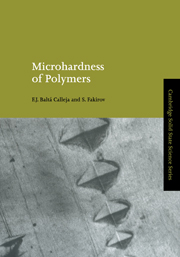Book contents
- Frontmatter
- Contents
- Preface
- Chapter 1 Introduction
- Chapter 2 Microhardness determination in polymeric materials
- Chapter 3 Microhardness of glassy polymers
- Chapter 4 Microhardness of crystalline polymers
- Chapter 5 Microhardness of polymer blends, copolymers and composites
- Chapter 6 Microhardness of polymers under strain
- Chapter 7 Application of microhardness techniques to the characterization of polymer materials
- Author Index
- Subject Index
Chapter 7 - Application of microhardness techniques to the characterization of polymer materials
Published online by Cambridge University Press: 23 October 2009
- Frontmatter
- Contents
- Preface
- Chapter 1 Introduction
- Chapter 2 Microhardness determination in polymeric materials
- Chapter 3 Microhardness of glassy polymers
- Chapter 4 Microhardness of crystalline polymers
- Chapter 5 Microhardness of polymer blends, copolymers and composites
- Chapter 6 Microhardness of polymers under strain
- Chapter 7 Application of microhardness techniques to the characterization of polymer materials
- Author Index
- Subject Index
Summary
In the previous chapters the main fields of application of the microhardness technique in polymer physics have been highlighted. The emphasis has been mostly on solving structural problems, looking for relationships between the structures of polymers and their properties (initially mechanical ones) or on studying the factors which determine the microhardness behaviour of various polymeric systems.
This chapter presents selected examples of the application of microhardness measurement for the characterization of polymeric materials after various physical treatments.
These include: the effect of the processing conditions on the mechanical properties of synthetic and natural polymers, the characterization of ion-implanted polymer surfaces, the study of mechanical changes in polymer implants after wear, the influence of coatings on surface properties, weatherability characterization of polymers, etc.
Effect on microhardness of processing conditions of polymers
The mechanical and physical properties of moulded parts, particularly those made of thermoplastics, do not depend only on the chemical constitution of the material and its properties. The processing conditions also exercise a considerable influence (Wilkinson & Ryan, 1999). Properties such as strength, toughness, hardness may vary to a greater or lesser extent in the same material, or can be selectively varied by choosing a particular processing technique. Those factors that determine the quality of a part are frequently not apparent externally, but are reflected by the internal structure of the part.
- Type
- Chapter
- Information
- Microhardness of Polymers , pp. 205 - 232Publisher: Cambridge University PressPrint publication year: 2000
- 1
- Cited by



